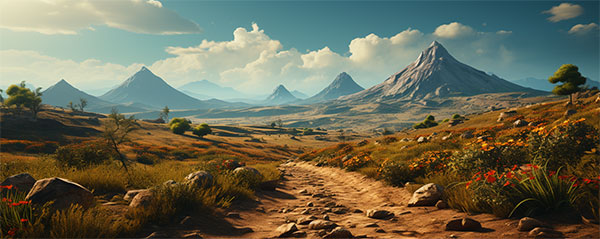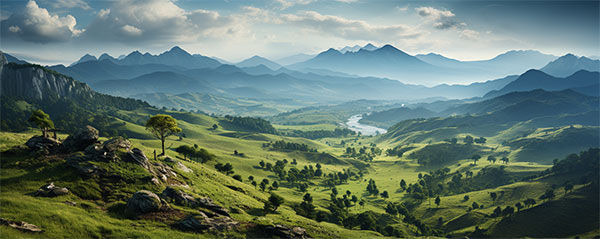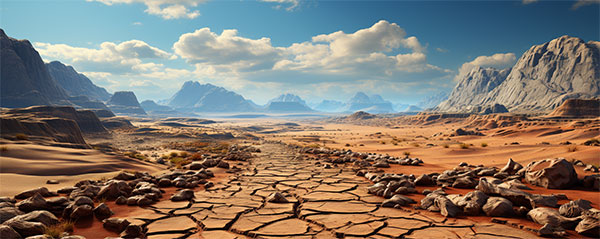
Sayarii History, Geography and Culture
Navigate this page
How to use this page
Begin by exploring global insights into Sayarii's history, climate, and cultural elements. Some of these sections link to detailed pages, while others utilize drop-down content blocks that expand when clicked, allowing you to learn more without leaving the page. Next, explore the world of Sayarii through a highly detailed world map, where you can zoom in and out to discover the entire world in intricate detail. Further down, in the "Explore by Region" section, find a close-up map of each region on the left, and a list of drop-down menus on the right. These menus allow you to delve into specific aspects of each region, such as cities, governments, cultures, languages, currencies, and weather. Simply click on the drop-down menu to explore options like "Cites and Governments of the Mchanga Hasira" or "Regional Cultures of the Bara Kusini." Links are activated as content is created. Currently content development is being driven by campaign design.
Sayarii History
Two Ages have shaped Sayarii: the Fallen Age (Ul'Mas Il'Saaqit) and the New Age (Ul'Eumr Il'Jadid). The Fallen Age, a 3,000-year-old technomagical civilization, thrived on a grand scale. Its people harnessed the power of both magic and technology to build magnificent cities and accomplish remarkable feats. However, the pride and ambition of this great society ultimately led to its downfall.
The Karithat ul'Qadima, or the Great Fall, marked the end of the Ul'Mas Il'Saaqit. Legend states that "the Old Gods", angered by the actions of their creations, unleashed a decade-long series of cataclysms that ravaged the world.

The Karithat ul'Qadima: A tempest of merciless floods and unforgiving sandstorms that swallowed entire cities. Populations were decimated, and in some places, reality itself fractured, seemingly contaminated by the imagination of its citizens.
Climate: Living Under a Crimson Sun
In the face of adversity or witnessing a tragic event, the people of Sayarii often murmur a time-honored phrase, "Tunaishi chini ya jua la damu" (We live below a crimson sun). This ancient wisdom speaks to the relentless challenges posed by the sun's unyielding heat. It's a reflection of a deeper truth about life on Sayarii, where the climate is not merely a weather pattern but a vivid manifestation of energy and life force. Over millennia, this heat has sculpted the planet, forging a diverse and resilient landscape that thrives under the watchful gaze of a crimson sun.
Polar Regions: Lush and Teeming with Life
Far from being icy wastelands, the polar regions of Sayarii are lush and abundant. Verdant forests stretch as far as the eye can see, interspersed with clear, sparkling lakes. The wildlife here has adapted to thrive in these milder northern climes, creating a rich and diverse ecosystem.
Temperate Zones: Warmth and Vitality
The temperate zones of Sayarii flow from pleasantly warm winters to hot, vibrant summers. The flora and fauna of these regions have adapted to the heat, exhibiting vibrant colors and unique adaptations to conserve water. Human settlements are designed to keep cool, with buildings featuring courtyards, water features, and shaded areas.
Equatorial Regions: Resilience in the Desert
Characterized by vast, sweeping deserts, the equatorial regions of Sayarii are a testament to the planet's warmth. Hardy species of plants and animals have adapted to the extreme conditions, and human civilizations have harnessed the sparse resources to survive. The golden sands and towering dunes are a striking symbol of resilience and adaptability.
Biodiversity: A Celebration of Life
Sayarii's biodiversity is a celebration of life's adaptability. From the polar forests to the equatorial deserts, each region boasts a unique array of flora and fauna. The creatures of Sayarii have evolved to thrive in the warmth, resulting in species that are as resilient as they are diverse.
Civilizations: Shaped by the Climate
The civilizations of Sayarii have been shaped by the planet's warm climate. Architecture, agriculture, and daily routines have been adapted to the heat. Buildings are designed to stay cool, crops are chosen for their heat tolerance, and many societies have adopted a siesta-like practice, resting during the hottest part of the day.
Thriving Under the Sun
Sayarii is a world that has not only adapted to its warm climate but has thrived under its relentless sun. It is a testament to the resilience of life and the endless possibilities that exist in the universe. The climate of Sayarii is not just a meteorological phenomenon; it is a living expression of the world's unique character, a melody of warmth that resonates with the heartbeat of the planet.
Elements of Culture
The elements of culture in Sayarii are not isolated artifacts; they are living expressions of a world shaped by unique astronomical phenomena. Mathematics, the calendar, and the celestial dance of the moons are interwoven, reflecting a culture that sees the divine in the natural world, that finds harmony in the rhythms of time, and that celebrates the cosmic symphony that shapes life on Sayarii.
To explore the cultures of the different regions of Sayarii - use the Explore by Region section below the World Map.
Calendar: A Dance of Time
The Sayarii calendar is a harmonious dance of time, reflecting the planet's elliptical orbit and the unique rhythms of life. The long year, with its two distinct summers and harvest seasons, shapes the agricultural practices and ecological adaptations of the world. Plants have evolved to thrive in the scorching summers and frigid winters, with dormant periods and specialized metabolisms that reflect the resilience and diversity of Sayarii's ecosystems.
The calendar also hosts unique festivals that celebrate both the seasons and the corresponding movements of The Sisters, the moons whose orbits create dramatic changes in the skyline. These celestial dances are not mere meteorological phenomena; they are vibrant expressions of culture, tradition, and cosmic harmony.
The Sayarii calendar is a harmonious dance of time, weaving together the celestial movements of the Sun Sisters, the planet's elliptical orbit, and the unique rhythms of life on Sayarii. With a 900-day year and 30-hour days, the calendar reflects the distinct astronomical and ecological characteristics of the world.
Seasons and Months
The year is marked by two long summers, known as the Sun Sisters or the Twins, a testament to the dramatic change in the skyline as one or another of the moons comes closer during the summer months. These summers are separated by long spring and fall-like seasons, breaking the summers from the "Ul'shita' Il'tawilat."
-
Long Winter (Ul'shita' Il'tawilat) - "Baridi Ka Abunuwasi"
- Months: Sayaad, Pharo
- A time of deep cold, the Long Winter is a season of endurance and reflection.
-
1st Spring - "Kipindi Ka Maua na Majnu"
- Months: Mufakir, Yatahamal
- Harvest Cycle: Seeding in Pharo, Harvest in Yatahamal
- A season of renewal and growth, marked by the planting of seeds and the first harvest.
-
1st Summer - "Kiangazi Sa Sungura"
- Months: Tajir, Eushaaq
- The hotter of the two summers, a time when many plants enter a dormant period, retreating to their water-saturated root systems.
-
1st Fall - "Kipupwe Sa Methali"
- Months: Hamil
- Harvest Cycle: Seeding
- A season of reflection and wisdom, marked by the planting of new crops.
-
Short Winter - "Baridi Ka Abunuwasi"
- Months: Burj, Sul
- A milder sister season to the Long Winter, a brief respite from the extremes.
-
2nd Spring - "Kipindi Ka Maua na Majnu"
- Months: Paani
- A second period of renewal, mirroring the first Spring.
-
2nd Summer - "Kiangazi Sa Sheba"
- Months: Abib, Shomu
- A milder summer, filled with the abundance of tree nuts, fruits, and perennial foods.
-
2nd Fall - "Kipupwe Sa Methali"
- Months: Kouji Nabot, Mtusi
- Harvest Cycle: Harvest
- A time of gathering and gratitude, marked by the second harvest of the year.
-
Return to Long Winter
- Months: Mwisho
- The cycle completes, returning to the deep cold.
Cultural Significance
The seasons of Sayarii are not mere meteorological phenomena; they are a vibrant tapestry of culture, tradition, and celebration. Each season hosts unique festivals that honor both the natural rhythms and the corresponding movements of The Sisters. The dramatic celestial dance of the moons during the summer months is a sight to behold, a symbol of the cosmic harmony that shapes life on Sayarii.
Astronomical Implications
The elliptical orbit of Sayarii creates a world of contrasts, from scorching summers to frigid winters. The unique climate leads to two harvest seasons, differing in length and bounty. The adaptation of plant life, with dormant periods and specialized metabolisms, reflects the resilience and diversity of Sayarii's ecosystems.
The Sayarii calendar is more than a measure of time; it's a living expression of the world's unique celestial dance, ecological richness, and cultural heritage. It's a testament to the interconnectedness of all life on Sayarii, a rhythmic symphony that resonates with the heartbeat of the planet.
Months of the Sayarii Calendar:
| # | Month | Season | Harvest Cycle |
|---|---|---|---|
| 1 | Sayaad | Long -Winter | |
| 2 | Pharo | Long -Winter / Spring | Seeding |
| 3 | Mufakir | 1st Spring | |
| 4 | Yatahamal | 1st Spring / Summer | Harvest |
| 5 | Tajir | 1st Summer | |
| 6 | Eushaaq | 1st Summer /1st Fall | |
| 7 | Hamil | 1st Fall | Seeding |
| 8 | Burj | Short-Winter | |
| 9 | Sul | Short-Winter / 2nd Spring | |
| 10 | Paani | 2nd Spring / 2nd Summer | |
| 11 | Abib | 2nd Summer | |
| 12 | Shomu | 2nd Summer /Fall | |
| 13 | Kouji Nabot | 2nd Fall | Harvest |
| 14 | Mtusi | Second Fall / Long -Winter | Harvest |
| 15 | Mwisho | Long -Winter |
Sayarii's Sexagesimal Mathematics: A Divine Gift
Mathematics is an integral part of Sayarii culture, seen as a divine gift from the old gods. The people of Sayarii use a base 60 or Sexagesimal numeral system, including zero "sufuri" as both a number and a placeholder. This system is believed to have divine providence, with the 900-day calendar, the 30-hour day, and the mathematical measurement of angles and geographic coordinates serving as proof of its sacred origin.
The Sexagesimal system is not just a theoretical construct; it permeates daily life. Merchants and buyers use it for everyday financial transactions, and hand counting allows for quick calculations and conveyance of prices or quantities. The system's sub-bases, called "Mikumi" or "hands" in Kawaida, enable people to count up to 60 using both hands, a practical application that reflects the cultural significance of mathematics.
Mathematics is an integral component of Sayarii culture, and an indispensable component of Thaumaturgy. The people of Sayarii use a base 60 or Sexagesimal numeral system with 60 as it's base (rather than 10), and include zero "sufuri" as both a number - and as a placeholder (see below). This system is believed to have been given to the world by the old gods, though the specific history of this "gift" is entirely lost. One will find that most older cultures in Sayarii will claim that the gift was theirs, though there there is little to no actual evidence of it's specific origins.
Mathematicians and Thaumaturgist both claim the world around them offers evidence of the systems origin, pointing to the 900 day calendar, the 30 hour day, the mathematical measurement of angles and geographic coordinates, and the 12 factors 1, 2, 3, 4, 5, 6, 10, 12, 15, 20, 30, and 60, of which 2, 3, and 5 are prime numbers, "sacred factors", as proof of the systems divine providence.
Aside from thaumaturgical uses the sexagesimal system is used uniformly by merchants and buyers for making everyday financial transactions both in currency and when they involve bargaining for and dividing up larger quantities of goods.
Sayariian Numerals
The sexagesimal system as used in Sayarii is not a pure base-60 system, in the sense that it does not use 60 distinct symbols for its digits. Instead, the digits use 12 as a sub-base in the fashion of a sign-value notation: The 5 sub-bases of 12 are called Mikumi - or "hands" in Kawaida The common tongue of eastern Bara Kusini.;
| 0 |
| 1 | 13 | 25 | 37 | 49 | |||||
| 2 | 14 | 26 | 38 | 50 | |||||
| 3 | 15 | 27 | 39 | 51 | |||||
| 4 | 16 | 28 | 40 | 52 | |||||
| 5 | 17 | 29 | 41 | 53 | |||||
| 6 | 18 | 30 | 42 | 54 | |||||
| 7 | 19 | 31 | 43 | 55 | |||||
| 8 | 20 | 32 | 44 | 56 | |||||
| 9 | 21 | 33 | 45 | 57 | |||||
| 10 | 22 | 34 | 46 | 58 | |||||
| 11 | 23 | 35 | 47 | 59 | |||||
| 12 | 24 | 36 | 48 | 60 |
*Denotes a sacred factor
0. Sifuri
1. Moja
2. Mbili
3. tatu
4. Nne
5. Tano
6. Sita
7. Saba
8. Nane
9. Tisa
10. Pili
11. Kwinda
12. Kumi
13. Kumi na Moja
14. Kumi na Mbili
15. Kumi na Tatu
16. Kumi na Nne
17. Kumi na Tano
18. Kumi na Sita
19. Kumi na Saba
20. Kumi na Nane
21. Kumi na Tisa
22. Kumi na Pili
23. Kumi na Kwinda
24. Ishirini
25. Ishirini na Moja
26. Ishirini na Mbili
27. Ishirini na Tatu
28. Ishirini na Nne
29. Ishirini na Tano
30. Ishirini na Sita
...
36. Lathini
,,,
48. Arobani
...
60. Sutini
Notation
Written numeric notation is done combining horizontal and vertical directions.
Base orders of 60 are represented horizontally with remainders expressed vertically below. In cases below 60, numbers are written vertically.
Examples below.
| 60 | |
| 120 | |
| 180 |
| 68 | 60 + 8 |
|
| 152 | 120 + 32 | |
| 201 | 180 + 21 |
Hand Counting
Counting is frequently performed using the thumb of the right hand to point to each of the three finger bones on each finger in turn, starting with the pinky bone closest to the the palm and moving out, allowing for people to count on their fingers to 12 on the right hand. On the left hand individual fingers are used to represent Mikumi or "hands", each finger of the left hand representing 12 in the same order, from the pinky to the index finger. Combined one can count or represent any number up to 60 in quick fashion. Using both hand allows Merchants to use hand signals to convey prices or quantity, and merchants will frequently be seen doing basic calculations using their fingers as a simple abacus.
Geography
Sayarii is a world that basks in the light of a hot sun. This is a planet that has been shaped and molded by its warm climate over thousands of years, resulting in a unique and vibrant tapestry of life and landscapes.
The polar regions of Sayarii, far from being icy wastelands, are lush and teeming with life. Verdant forests stretch as far as the eye can see, interspersed with clear, sparkling lakes. The wildlife here is diverse and abundant, with creatures that have adapted to thrive in these milder northern climes.
The temperate zones of Sayarii are places of warmth and vitality. Here, the seasons flow from pleasantly warm winters to hot, vibrant summers. The flora and fauna of these regions are adapted to the heat, with many species exhibiting vibrant colors and unique adaptations to conserve water and thrive in the warmth. Human settlements in these regions are designed to keep cool, with buildings often featuring courtyards, water features, and shaded areas.
The equatorial regions of Sayarii are a testament to the planet's warmth. These areas are characterized by vast, sweeping deserts, where the sun beats down on golden sands and towering dunes. Yet even here, life thrives. Hardy, resilient species of plants and animals have adapted to the extreme conditions, and human civilizations have found ways to harness the sparse resources to survive.
Sayarii's biodiversity is a testament to the adaptability of life. From the polar forests to the equatorial deserts, each region boasts a unique array of flora and fauna. The creatures of Sayarii have evolved to thrive in the warmth, resulting in a variety of species that are as resilient as they are diverse.
The civilizations of Sayarii have also been shaped by the planet's warm climate. Architecture, agriculture, and even daily routines have been adapted to the heat. Buildings are designed to stay cool, crops are chosen for their heat tolerance, and many societies have adopted a siesta-like practice, resting during the hottest part of the day.
Sayarii is a world that has not only adapted to its warm climate but has thrived under its relentless sun. It is a testament to the resilience of life and the endless possibilities that exist in the universe.
A Map of the World
Explore By Region

- Bachal
- Mdaj Bahuft
- Kuogopa - the Petrified City
- Kuogopa Archeological Project
- Il-Wāāt ul'Ihāt Kathira
- Visiwa vya Shungwe la Hasira Pwani
- Mdimo il Rojo
- Eumlat Masruqa
- Nephisis
- Il'Bisothi Hurar
- The Mchanga Pwanii - Coastal People of Mchanga Hasira
- The Qāāzami - The Desert Tribes
- Dasar Laut - The Seaborn
- Kawaida
- Saahil Kalima
- Chumvi - "Salt" Language of the Dasar Luat
- Qāāzana'i Kalima
- Lugha ya Mbao
Northern Mchanga Hasira: Bachal to Il-Wāāt ul'Ihāt Kathira
The Hazina Dada ~ The Rich Sisters

- Divai - Northern Hazina Dada Island
- Matunda
- Embe - Southern Hazina Dada
- Mji wa Soho
- The Fēixiān
- The Seaborn
The Fēixiān Paku
Regional Weather
Ul'Harbiya Il'Sultaniya Saahilian ~ The Eastern Sultanate

- Jidar ul' Bahr
- Tath-Puur
- Brethii
- Tooj Madoo
- Juud
- Golohn
- Tookoth
- Tooasj
- Il'Shuwfan
- Vini Peftnaan
- Vimage
- Hisa' il'Tuyur
- Fasi
- Bizehi
- Beheemi
- Binapp Parush
- Ta'Abbatha il'Ghul
- Trebi
- Fet
- Jinae
- Khamr
- Juut
- Hafr ul'Weeāss
- Jawahir
- Ahdhia Turkidh
- Coming soon
- Coming soon
Coming soon
Coming soon
Taur Norui

Coming Soon
- Coming Soon
- Coming Soon
Coming Soon
Coming Soon
Mto Umejaa

Coming Soon
Coming Soon
Coming Soon
Coming Soon
Coming Soon
Dôr Edain

Coming Soon
Coming Soon
Coming Soon
Coming Soon
Coming Soon
Nufayat ul'Qahila

Coming Soon
Coming Soon
Coming Soon
Coming Soon
Coming Soon
![tychodreq_filigreed_nomad_riding_a_flying_carpet_48513975-d98d-4bd4-8d96-c4dc4d88b94f[1].png](http://sayarii.world/application/files/3516/9012/3472/tychodreq_filigreed_nomad_riding_a_flying_carpet_48513975-d98d-4bd4-8d96-c4dc4d88b94f1.png)